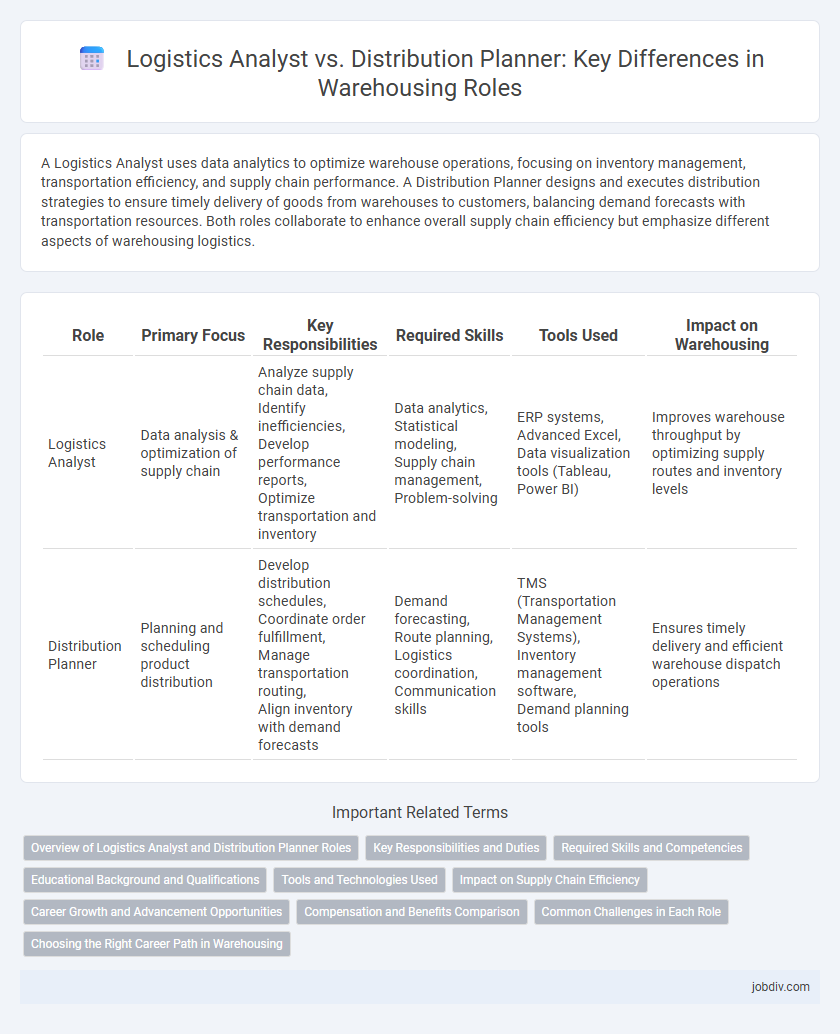A Logistics Analyst uses data analytics to optimize warehouse operations, focusing on inventory management, transportation efficiency, and supply chain performance. A Distribution Planner designs and executes distribution strategies to ensure timely delivery of goods from warehouses to customers, balancing demand forecasts with transportation resources. Both roles collaborate to enhance overall supply chain efficiency but emphasize different aspects of warehousing logistics.
Table of Comparison
| Role | Primary Focus | Key Responsibilities | Required Skills | Tools Used | Impact on Warehousing |
|---|---|---|---|---|---|
| Logistics Analyst | Data analysis & optimization of supply chain |
Analyze supply chain data, Identify inefficiencies, Develop performance reports, Optimize transportation and inventory |
Data analytics, Statistical modeling, Supply chain management, Problem-solving |
ERP systems, Advanced Excel, Data visualization tools (Tableau, Power BI) |
Improves warehouse throughput by optimizing supply routes and inventory levels |
| Distribution Planner | Planning and scheduling product distribution |
Develop distribution schedules, Coordinate order fulfillment, Manage transportation routing, Align inventory with demand forecasts |
Demand forecasting, Route planning, Logistics coordination, Communication skills |
TMS (Transportation Management Systems), Inventory management software, Demand planning tools |
Ensures timely delivery and efficient warehouse dispatch operations |
Overview of Logistics Analyst and Distribution Planner Roles
Logistics Analysts specialize in evaluating supply chain processes to identify inefficiencies and recommend improvements, using data-driven techniques and software tools. Distribution Planners focus on coordinating the movement and storage of goods, optimizing delivery schedules, and managing inventory levels to ensure timely distribution. Both roles require strong analytical skills and a deep understanding of warehouse operations, but Logistics Analysts emphasize strategy and process optimization, while Distribution Planners concentrate on execution and resource allocation.
Key Responsibilities and Duties
A Logistics Analyst primarily focuses on analyzing supply chain data to optimize warehousing operations, inventory management, and transportation efficiency. In contrast, a Distribution Planner is responsible for developing and implementing distribution schedules, coordinating shipments, and managing route planning to ensure timely delivery. Both roles require proficiency in data analysis and logistics software but emphasize different aspects of warehousing and supply chain management.
Required Skills and Competencies
Logistics Analysts require strong analytical skills, proficiency in data management software, and the ability to interpret supply chain metrics to optimize transportation and inventory costs. Distribution Planners must excel in demand forecasting, route optimization, and coordination of warehouse operations to ensure efficient stock distribution and timely deliveries. Both roles demand problem-solving abilities, attention to detail, and effective communication with supply chain partners.
Educational Background and Qualifications
A Logistics Analyst typically holds a degree in supply chain management, logistics, or business administration, with strong analytical skills and proficiency in data analysis software being essential qualifications. Distribution Planners often require a similar educational background but may emphasize expertise in demand forecasting, inventory management, and advanced planning systems such as SAP or Oracle. Both roles benefit from certifications like APICS CPIM or CSCP, enhancing knowledge in supply chain processes and operational efficiency.
Tools and Technologies Used
Logistics Analysts leverage advanced data analytics software, such as Tableau and SQL databases, to optimize supply chain efficiency by analyzing shipment data and forecasting demand patterns. Distribution Planners utilize Warehouse Management Systems (WMS) like SAP EWM and transportation management platforms to coordinate inventory flow and schedule deliveries in real time. Both roles rely heavily on automation tools, RFID tracking, and GPS technology to enhance accuracy and streamline warehouse operations.
Impact on Supply Chain Efficiency
Logistics Analysts enhance supply chain efficiency by analyzing data to optimize transportation routes, reduce costs, and improve delivery times. Distribution Planners directly impact supply chain performance by coordinating inventory allocation and scheduling shipments to meet demand accurately. Both roles leverage data-driven strategies to minimize delays and increase overall operational responsiveness within warehousing logistics.
Career Growth and Advancement Opportunities
Logistics Analysts specialize in data-driven optimization of supply chain operations, offering career advancement through roles in supply chain management and operations strategy. Distribution Planners focus on inventory allocation and transportation scheduling, with growth opportunities in logistics coordination and distribution management. Both career paths provide strong potential for advancement into senior logistics or supply chain leadership positions.
Compensation and Benefits Comparison
Logistics Analysts typically earn an average salary ranging from $60,000 to $85,000 annually, with benefits including health insurance, retirement plans, and performance bonuses reflecting their role in data-driven supply chain optimization. Distribution Planners often command slightly higher compensation, averaging between $65,000 and $90,000, due to their strategic involvement in inventory control and distribution network management, complemented by similar benefits packages and additional allowances for shift differentials. Both positions offer opportunities for professional growth, but Distribution Planners may receive higher incentives tied to operational efficiency improvements.
Common Challenges in Each Role
Logistics Analysts often face challenges in data accuracy and real-time tracking, impacting supply chain visibility and decision-making efficiency. Distribution Planners commonly encounter difficulties in inventory optimization and demand forecasting, leading to potential stockouts or overstock situations. Both roles require advanced analytical skills and collaboration with multiple departments to streamline warehouse operations and reduce costs.
Choosing the Right Career Path in Warehousing
Logistics Analysts specialize in optimizing supply chain efficiency through data analysis and forecasting, making them ideal for roles that require strategic decision-making and process improvement. Distribution Planners focus on managing inventory flow and coordinating shipments to ensure timely delivery, excelling in operational roles within warehousing environments. Selecting the right career path depends on whether you prefer analytical problem-solving with a focus on data insights or hands-on management of distribution networks.
Logistics Analyst vs Distribution Planner Infographic

 jobdiv.com
jobdiv.com